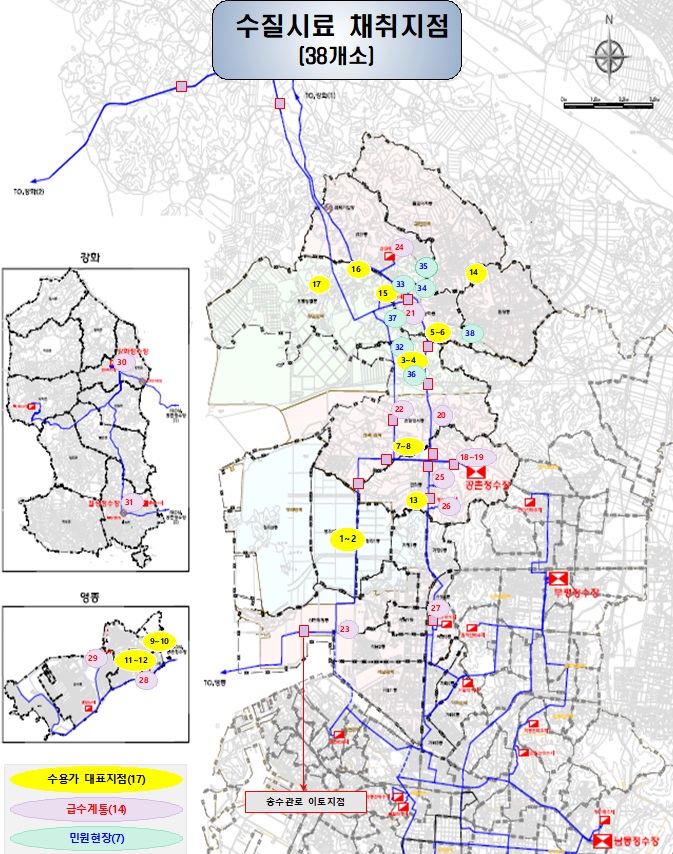환경부 수돗물 안심지원단*(이하 지원단)은 인천시 수돗물 정상화작업 진행상황 및 수질검사 분석 결과를 6월 24일 공개했다.
* 환경부, 국립환경과학원, 한국수자원공사, 한국환경공단 등 관계기관 합동 23명으로 구성(단장: 정현미 국립환경과학원 환경기반연구부장)
이번 공개는 6월 22일부터 시작한 1차 수돗물 시료를 분석한 것으로 수돗물 수질현황, 정상화조치에 따른 수질효과 등을 분석했었다.
1차 수질검사(6월 22일 채수)는 공촌정수장 등 총 38개 지점*에 대해 망간, 철, 탁도, 증발잔류물 등 총 13개 항목**이며, 분석 결과 먹는물 수질기준에 적합한 것으로 확인 하였다고 밝혔다.
* 공촌정수장 급수구역 수질변화를 체계적으로 파악하기 위한 송수관로·배수지 등 급수계통(14개소) 및 수용가 대표지점(17개소), 수질상태가 심각한 민원가정(7개소)
** 기본수질항목 pH·잔류염소, 알갱이 등 척도가 되는 탁도·증발잔류물, 수도관벽에서 이탈되어 수돗물에 포함될 가능성이 높은 알루미늄·망간·철·아연·구리·납·크롬·비소·카드뮴 등
다만, 탁도(기준: 0.5NTU)는 급수계통(0.09~0.26NTU, 평균 0.12)에 비해 수용가 대표지점(0.08~0.39NTU, 평균 0.16) 및 민원가정(0.10~0.19NTU. 평균 0.14)에서 다소 높은 것으로 나타났다.
- 망간(기준: 0.05mg/L)은 급수계통과 지원단에서 직접 방문하여 채수한 가정(7곳)에서는 검출되지 않았으며, 수용가 대표지점* 중 심곡동 1개 지점(0.004mg/L)과 운남동 2개 지점(0.010, 0.014mg/L)에서만 검출되었다.
* 수질현황 분석을 위해 행정동별로 대표지점 17개소를 매일 조사
- 이는 급수계통에 대한 청소효과가 단계별로 나타나고 있으나, 급수말단인 수용가에 도달하기까지 시일이 다소 소요되는 것으로 보인다고 하였다.
- 지원단은 불로동 등 여전히 수질문제가 제기되는 민원가정에 대해 실태조사 및 수질검사를 실시하여 원인을 분석하고 조치할 계획이라 밝혔다.
한편, 가정내 수돗물 필터가 변색되고 있는 상황에 대한 지역주민의 이해를 돕고 보다 정확한 수질상태를 판단할 수 있도록 국립환경과학원에서는 별도의 분류방법*을 마련하고 하였다.
* 시료로 사용되는 수돗물의 양, 필터의 재료 및 공극크기 등을 표준화하고 수질상태를 5단계로 분류(좋음, 양호, 보통, 나쁨, 아주나쁨) 등
‘정상화지원반*’은 6월 18일 공촌정수장 4개 정수지, 6월 24일까지 배수지 8곳(15개지)에 대한 청소를 모두 완료하는 등 급수계통별 이물질 청소를 체계적으로 추진하고 있다고 밝혔다.
* 인천시, 환경부, 한국수자원공사, 한국환경공단 등 관계기관 합동 25명으로 구성(반장: 환경부 이호상 서기관)
송수관로의 이물질을 제거하는 이토(물배수) 작업은 6월 19일부터 15개 지점에서 소화전과 이토 밸브를 통해 매일 지속적으로 실시(4만 4천톤/일)하고 있다.
- 정상화지원반은 방류효율 증대 및 수질정상화 기간 단축을 위해 6월 22일 예비배수지(왕길배수지)를 퇴수구로 활용하여 이토 작업을 실시한 바 있다고 밝혔다.
인천시와 교육청, 서구·중구청은 취약계층 및 수돗물 민원 집중지역의 식수불편을 해소하기 위해 병입수돗물, 생수 및 학교급식 지원을 계속하고 있고 전했다.
인천시는 지난 21일 이후 병입수돗물 9,800병, 생수(먹는샘물) 258톤을 추가 지원했고, 시 교육청은 수돗물 피해 160개 학교(유치원 포함) 중 생수(105개교), 급수차(42개교) 등 147개교를 지원 중에 있다고 했다.
지원단은 수질검사결과, 정상화작업 일정 및 계획 등에 대해 정보를 매일 투명하게 공개하고 수돗물 정상화 시기를 앞당기기 위해 최선을 다할 예정이라 밝혔다. [영종뉴스 우경원 기자]

A total of 38 places 13 items where the water quality is somewhat higher than the water supply system, such as water supply, or within the water quality standards. The Ministry of Environment's Tap Water Relief Support Group* (hereinafter support group) released the results of the analysis of the process of normalizing tap water in Incheon city and water quality inspection on June 24th. Consists of 23 related organizations such as the Ministry of Environment, National Academy of Environmental Sciences, Korea Water Resources Corporation, and Korea Environment Agency (Director: Jung Hyun-Mi, Director of Environmental-Based Research at the National Academy of Environmental Sciences) The release was an analysis of the first tap water samples that began on June 22, and analyzed the status of tap water, the water quality effect of the normalization measures, etc.
The first water quality test (held on June 22nd) consists of a total of 13 items, such as manganese, iron, turbidity, evaporative residues for a total of 38 branches, such as the Kochon water purification plant, the analysis confirmed that it is suitable for the water quality standards of eating water.
Water supply system (14 places) such as water pipes and drains for systematic understanding of water quality changes in the water supply area in The Gongchon Water Purification Plant ( 17 places), civil families with severe water quality conditions (7 places)
Basic water quality items pH, residual chlorine, water quality residues that are measured by grains, aluminum, manganese, iron, zinc, copper, lead, chromium, arsenic, cadmium, etc. that are deviated from the water pipe wall and are likely to be included in tap water. However, the turbidity (reference: 0.5NTU) is a water supply system (0.09 to 0.26NTU, average 0.12) compared to the acceptance point (0.08 ~ 0.39NTU, average 0.16) and the civil service home (0.10 to 0.19NTU) was found to be somewhat higher on average. Manganese (reference: 0.05mg / L) was not detected in the home (7 places) collected by visiting directly from the water supply system and support group, the acceptance was detected only in the representative point * of the shimgokdong 1 point (0.004mg / L) and two points in Yunnam-dong (0.010, 0.014mg / L).
Daily survey of 17 representative branches by administrative building for analysis of water quality. This, but the cleaning effect on the water supply system appears step by step, it seems that the time is somewhat to reach the water ingress. The support team said that it plans to analyze the cause and take action by conducting a survey and water quality inspection on the families of the complaints who still have water quality problems, such as bulodong. On the other hand, to help local residents understand the situation in which the tap water filter in the home is discolored and to determine the more accurate water quality condition, the National Academy of Environmental Sciences was to provide a separate classification method. Standardize the amount of tap water used as a sample, the material and pore size of the filter, and classify the water quality status in five stages (good, good, normal, bad, very bad) On June 18, The Normalization Support Group announced that it is systematically promoting the cleaning of foreign substances by the water supply system, including the cleaning of all four water purification plants in The Gongchon, and eight drainage (15) by June 24. Consists of 25 members of the relevant organizations such as Incheon City, Ministry of Environment, Korea Water Resources Corporation, Korea Environment Agency, etc. (Vice President: Lee Ho-sang Scribe of the Ministry of Environment) Ito (water drainage) operation to remove foreign objects from the water pipe is carried out daily continuously (44,000 tons / day) through hydrants and ito valves at 15 locations from June 19th. The Normalization Support Group announced that it had conducted ito work by utilizing the reserve drain (Wanggil drain) as a detention center on June 22 to increase discharge efficiency and shorten the water quality period. The City of Incheon, the Ministry of Education, and the Western and Central District Offices are continuing to support bottled water, bottled water, and school meals in order to relieve drinking water inconvenience in vulnerable and tap-water areas.
Since the last 21 days, the city has provided an additional 9,800 bottles of bottled water and 258 tons of bottled water (spring water), and the city school district said it is supporting 147 schools, including 105 schools (105 schools) and 42 water supply vehicles, out of 160 schools (including kindergartens) that have been affected by tap water.
The support group will do its best to make the information transparent daily and speed up the time to normalize tap water, including the results of water quality inspections, the schedule and plans for normalization work.


